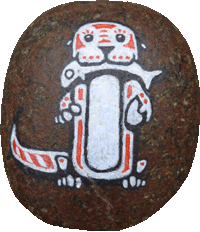South Africa is a stunning country for wildlife and scenery. As though there weren’t enough guidebooks already, here’s our brief lowdown on the country for travellers. For prices below, the exchange rate was about R10 to £1 when we visited.
Accommodation

You can get a good, comfortable, spacious room in a B&B or guesthouse for between R400 and R500 pretty much anywhere in the country, though Cape Town might be a stretch. Private rooms in the backpacker places we tried were no cheaper. The best thing about staying in B&Bs is that all the South Africans we met were incredibly hospitable and helpful – something you won’t get in the professional environment of a hotel. Places advertised as self-catering are often cheaper than B&B, so a good option even if you’re eating out. Don’t waste your time asking for accommodation at Tourist Info offices – these are agents on commission, and we found them mostly useless. Find a B&B (many have signposts) and if they are full or too expensive, ask them for other suggestions.
Food

South African restaurants revolve around meat, and the steak tends to be good. For the record, the Northern Cape province served up the best meat at good prices. Eating out here is cheap. A decent meal for two including a glass of wine could be R150 away from the main tourist places. Expect big portions and robust or creamy sauces – think USA. Even gourmet cooking in the winelands was half the price we’d pay for similar quality in England. As an odd contrast, supermarket food tends to be fairly expensive; R8 for a tin of chopped tomatoes. Obviously it’s still cheaper to self-cater, but the main reason to do so is to actually get some veggies! Local specialities like bobotie, sosaties and bredie are worth a try, but it’s not really a distinguished cuisine.
Drink
 In the Northern Cape you could get a bottle of decent table wine in a restaurant for R30, and elsewhere we didn’t have to pay much more. It’s mostly young, easy-drinking stuff, the most consistently good choices (in the absence of experience) being pinotage and cabernet sauvignon. Coffee is hit-and-miss; I had good cappuccino in Simon’s Town and vile, feeble swill with an aftertaste of metal and armpit from a restaurant in the Kruger. Fruit juice pissed me off. With all the fruit South Africa produces and sends to England, why do their own supermarkets and so many restaurants prefer to offer “juice blends” including extra sugar along with permitted flavourings and colourings? The tap water is all great in South Africa – don’t by bottled!
In the Northern Cape you could get a bottle of decent table wine in a restaurant for R30, and elsewhere we didn’t have to pay much more. It’s mostly young, easy-drinking stuff, the most consistently good choices (in the absence of experience) being pinotage and cabernet sauvignon. Coffee is hit-and-miss; I had good cappuccino in Simon’s Town and vile, feeble swill with an aftertaste of metal and armpit from a restaurant in the Kruger. Fruit juice pissed me off. With all the fruit South Africa produces and sends to England, why do their own supermarkets and so many restaurants prefer to offer “juice blends” including extra sugar along with permitted flavourings and colourings? The tap water is all great in South Africa – don’t by bottled!
Transport
 We drove everywhere, in a basic silver VW Polo 1.4, and didn’t experience public transport at all (unless you include the Table Mountain cablecar?). The roads are generally excellent, even a lot of the secondary dirt roads can be cruised (alertly!) at 60mph. Some minor tarmac roads have potholes, but generally patch repaired or too shallow to do more than spill your coffee. A 4×4 would be better, but they’re three times the price to hire. There’s very little traffic, and contrary to guidebook hyperbole we only saw two examples of insane overtaking maneuvers in 7 weeks and 10,000 kms of driving.
We drove everywhere, in a basic silver VW Polo 1.4, and didn’t experience public transport at all (unless you include the Table Mountain cablecar?). The roads are generally excellent, even a lot of the secondary dirt roads can be cruised (alertly!) at 60mph. Some minor tarmac roads have potholes, but generally patch repaired or too shallow to do more than spill your coffee. A 4×4 would be better, but they’re three times the price to hire. There’s very little traffic, and contrary to guidebook hyperbole we only saw two examples of insane overtaking maneuvers in 7 weeks and 10,000 kms of driving.
Petrol was about R350 to fill the Polo, and it’s customary to tip the petrol attendant a few rand if he cleans your windscreen or does any other little service. Cities might have formal metered parking in the centre, but in most places you might just find a guy in a high-vis jacket hanging around to “keep and eye on your car”. We tended to give these guys R5 on our return – they’re entirely unofficial, but still performing a useful service.
Weather
 In August and September, which is spring, we found a pretty wide range. Cape Town varied from fleeces and jackets one day to T-shirts the next, but the nights were always cold. Away from the coast it definitely becomes warmer, but still with cold nights – we had a frost at Tillitudlem, and then the day reached about 30C. The lowveldt (i.e. the Kruger) is noticeable for being scorching in the day and still warm at night.
In August and September, which is spring, we found a pretty wide range. Cape Town varied from fleeces and jackets one day to T-shirts the next, but the nights were always cold. Away from the coast it definitely becomes warmer, but still with cold nights – we had a frost at Tillitudlem, and then the day reached about 30C. The lowveldt (i.e. the Kruger) is noticeable for being scorching in the day and still warm at night.
Scams and hassle
 We didn’t get any. Even the African curio stalls at tourist places, which we expected to burst forth with people trying to be our friend and sell us stuff, were not. There were a few beggars in Cape Town, but we just said “no” and then ignored them. The only scam worthy of note is the informal parking attendants. The rule is: they keep an eye on your car, and when you return you give them a few rand. If you look unsure, or ask them how much to park, they’ll make up a nice price like R20 and ask for it up front (silly tourists).
We didn’t get any. Even the African curio stalls at tourist places, which we expected to burst forth with people trying to be our friend and sell us stuff, were not. There were a few beggars in Cape Town, but we just said “no” and then ignored them. The only scam worthy of note is the informal parking attendants. The rule is: they keep an eye on your car, and when you return you give them a few rand. If you look unsure, or ask them how much to park, they’ll make up a nice price like R20 and ask for it up front (silly tourists).
Crime and security

We didn’t see or experience any criminal behaviour in South Africa, but nevertheless all our accommodation was typically well locked and barred, and every house has a gate. Wherever you stay, just ask your hosts whether it’s a safe area to walk around at night – apart from Cape Town, all the places we visited were. It goes without saying that we didn’t walk around with a camera on show except in wildlife reserves and parks. We drove through one township by accident, but no-one batted an eye.
Hiking and wildlife watching

South Africa has a fantastic range of natural environments and wildlife to match. There are also lots and lots of National Parks and nature reserves to cover all these environments; it might well be that South Africa is the best overall country for wildlife watching in the world. If you’re coming for wildlife, think seriously about getting a Wild Card – ours gave free entry to pretty much all the parks and reserves, probably saving £200+ on the trip.
Hiking is different from England. You can’t just grab a map, pick a suitable footpath and start walking – there aren’t footpaths. Instead, the various parks and places to visit will have a number of trails laid out; sometimes a disappointing 1 or 2 trails of a couple of kms, other times a wide range of options up to and beyond a day. And most hikes require a bit more fitness than a stroll in the Surrey hills! The path often gets rocky, or steep, but usually at least fairly clear and often signed.
Regional variations
Cape Town and around is the civilised bit of South Africa, every bit as engaging for the cultural senses as a European break. We found other little pockets of “boutique” South Africa as we travelled around – a couple of villages on the Midlands Meander, Graaf-Reinet in the Karoo – but otherwise the rest of non-city South Africa is pretty provincial. Go for the natural beauty and the wildlife. The Northern Cape is vast and empty, with huge landscapes and endless roads with no-one on them. For beautiful landscapes, the Drakensbergs and the Blyde River stand out; both seemed more beautiful to us than the Garden Route (though Storms River stands out). The Kruger beats Kgalagadi for quantity of game viewing, but the desert is a nicer backdrop and you certainly feel out in the wilderness.
Conclusion
We enjoyed South Africa, and will definitely return – it combines our two favourite activities; walking and watching wildlife. If you have any other questions, so that we can expand our nutshell summary, post them in the Comments please!
Related Images:














































Well im very jealous!! From your write ups and pictures, you sure have had an amazing time so far and you have only just started…the small part of South Africa I got to see when out there made me want to go back, it is a wonderful place with some friendly peoples. Well keep up on the updates they are a joy to read and take care…love ya both 😀
In three particular places (Tillietudlem, the Drakensbergs and Blyde River canyon) I thought to myself “Dan has to come here some day”. Totally up your street. Mind you, if you want to combine 4×4 driving and an amazing landscape I reckon the Ais-Richtersveld transfrontier park is probably even more perfect – talk about getting away from it all. We had a VW Polo, so we did NOT go there.
Am I the only person who loves the name Tillietudlum? It sounds like the sort of place that should be inhabited by lots of multicoloured TellyTubbies 😉
OK. South Africa, amazing… Check! Wowee.